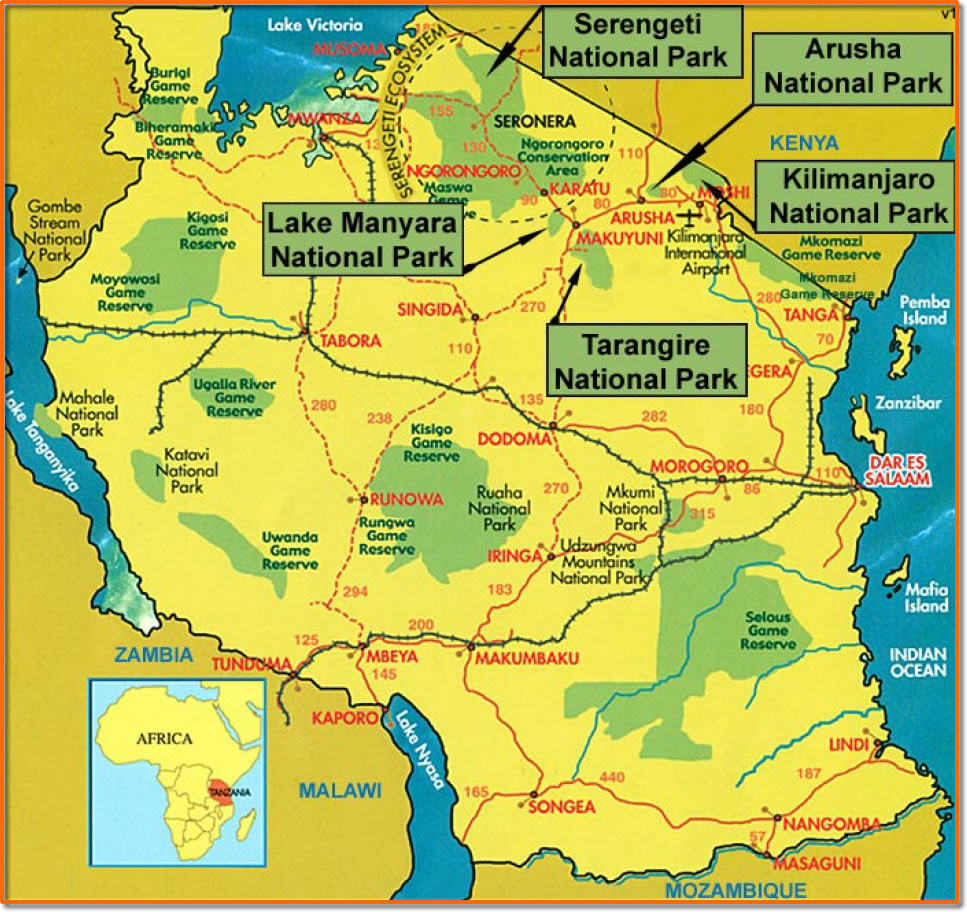
Geography
Tanzania is situated just south of the Equator bordering the Indian Ocean for a stretch of 800km of unspoiled beach with an area of 939,701sq.km (which embraces the islands of Zanzibar, Pemba and Mafia). It is the largest country in East Africa.
The main physical features vary from coastal plain (m. above sea level) to Rift Valley, Miombo woodlands, Southern highlands and Northern mountains. (5,895m above sea level).
Temperatures vary from 15c in the highland areas to 30c along the coast. It is cool between May and October. Rains occur between November and May.
Visas All visitors to Tanzania require, apart from a valid passport, visas, with the exception of citizens of the Commonwealth and other specified countries.
Health
Visitors originating from countries infested with cholera and yellow fever should have with them valid vaccination certificates. Although mosquito control and the high altitude of Northern Tanzania greatly reduce the risks of malaria, it is advisable to take a weekly preventive dose against malaria both before, during and after the tour.
Currency
Importation of foreign currency by visitors is unlimited. It is illegal to import or export Tanzania currency. Foreign currency, cash as well as travelers cheques, may be exchanged at Bureau de Change shops found at airports, in all major towns and border posts.
Customs
Personal effects including binoculars, cameras and film may be imported temporarily free of duty. A customs bond may be demanded from visitors bringing in video/filming equipment, radio tape recorders and musical instruments to ensure the goods are re-exported. Visitors buying valuable gems, skin articles, Makonde carvings and other local handcrafts must keep cash sales receipts for presentation to customs officials on departure.
Departures
An airport tax of US$ 30 (this is subject to review) or its equivalent in convertible foreign currency is levied on all visitors departing to country. Baggage is weighed at check-in counters and may be inspected by customs officials.
Climate and Clothing
Located at an altitude of 5,000 to 7,600 feet, northern Tanzania’s dry sunny climate is nothing like the steamy African jungle of Tarzan movies. The weather is spring-like year round, with daytime temperatures in the 70s and 80s, evenings in the 60s. Though Tanzania within the tropics, temperatures are mainly governed by altitude varying from hot and humid or the coast to warm and dry in the central plateaus. The main rainy season is from February to May, the hottest months being from October to February.
Clothing should be light and informal while on safari and on the coast. Warm clothing is recommended in the evenings and particularly in higher altitude around Ngorongoro Crater, Arusha, Mount Kilimanjaro areas, Usambara and Southern Highlands. Low heeled walking shoes are recommended. Other accessories like a hat, sunglasses, swimsuits, flashlight and insect repellent will be useful.
Language
The National language is Kiswahili (Swahili) but English is widely spoken. Tourists on Safaris can be provided with guides who speak their countries languages.
Local Time Local time: GMT + 3 Hours. 5/7/2010 1:51:17 PM
Suggested International Flights
- KLM Airlines
- Northwest Airlines
- British Airways
- Kenya Airways
- African Travel Centre Airlines
- Air France
- Austrian Airlines
- Emirates
- Japan Airlines
- Air Lufthansa
- Scandinavian Airlines(SAS)
- Swiss Air
- Air Canada
- Condor
- Ethipian Airlines
Suggested Internal Flights in East Africa These flights operate scheduled flights to all national parks and tourists destinations in Tanzania and East Africa as a whole. Also operates executive and contract air charters.
- PrecisionAir
- Coastal Travel Aviation
- Zan Air
- Regional Air
- Air Kenya
- Fly540
- Safari Airlink